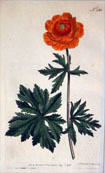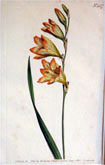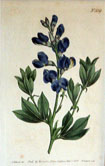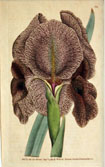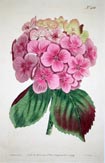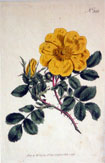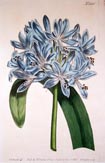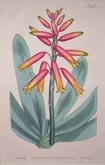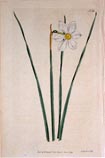
 |
(Click images to enlarge and for purchase information.) Want to know more about prints? |
|
|
William Curtis (1746-1799) was the son of a Quaker, who was a tanner. Curtis was apprenticed to his grandfather, the town surgeon/apothecary, because he had such an interest in the local flora and fauna (all medicine was plant derivative). He worked for two apothecaries and briefly had his own practice, but the naturalist prevailed over the apothecary. He soon developed his own public garden and began to publish botanical pamphlets. As his reputation as a naturalist grew, he received in 1773, an appointment in as Demonstrator of Botany at the Chelsea Physic Garden. Curtis continued to publish; this time a series of lectures he had given students on Linnaeus’ system of botany. Curtis’ goal, during these years was the publication of his greatest work, the Flora Londinensis 1777-98, which attempted to describe and illustrate life size, all wild plants growing within a 10-mile radius of the center of London. Curtis sincerely hoped this acclaimed publication would bring him fame and fortune. The monumental work was issued in parts by subscription (see my “Want to Know More About Prints?” link). Each part cost two shillings and sixpence uncolored, five shillings colored, and seven shillings and six pence for the few with superior coloring. Curtis hired William Hilburn as artist. He was succeeded by James Sowerby, Sydenham Edwards, Thomas Milton and Francis Sanson . It took Curtis 23 years to publish 72 parts. The work was bankrupting him and he was forced to end it in 1798. Fortunately in 1787 he had begun another publication, The Botanical Magazine, to shore up his declining finances. It had a smaller format, about 7”x 10”, combined with a goal, which peeked subscriber interest, of depicting the most beautiful and interesting plants from new discoveries around the world. These plants, mostly flowering, were beautifully illustrated and colored. The included descriptive text, stated who discovered the plant, its native origins whether it could be propagated in England and, if so, how. Many of the plants Curtis depicted were being grown by him and could be purchased, providing him additional income. Curtis had found a very successful formula. The Botanical Magazine had as many as eight different periodical competitors in its long history, but outlasted them all, to become the longest continually published periodical in history. It is still in publication today!
|
||

